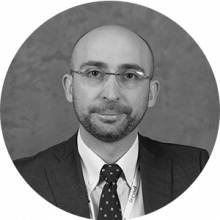Digestive
Introduction
Presentation
In Module Two, we approach the “Digestive System” in 4 parts: the esophagus, stomach, small bowel, and colon. An additional chapter will focus on bariatrics. For each, we discuss the unique anatomy, pathology, surgical and endoscopic knowledge and the complications involved. We will cover diagnostic EGD, surveillance and treatment of Barrett’s esophagus (including advanced imaging techniques) and therapeutic basics such as biopsy, tissue resection and ablation – for esophagus and stomach as well. From there we address enteral access and the unique diagnostic and therapeutic issues in the colon and rectum. Special interests and focus also include advanced therapeutic endoscopy, comprehensive open and laparoscopic surgical care for complex laparoscopic foregut surgery, inflammatory bowel disease surgical care, colorectal and anorectal surgery, surgical care for gastrointestinal malignancies using evidence-based practice guidelines.
We will then revisit the stomach in regard to bariatrics, first discussing endoscopic management of failures and complications after primary surgery. Finally we cover the rapidly evolving area of primary endoscopic bariatric and metabolic procedures.
 17
lessons
17
lessons
 21
speakers
21
speakers
 18:50
hours
18:50
hours
 229
followers
229
followers
Course directors

Silvana Perretta

Ivo Boškoski

Manoel Galvao Neto
Objectives
- Safely and effective access the upper and lower GI tract with a variety of endoscopes.
- Recognize and manage abnormal findings of the GI tract, with an understanding of the pertinent anatomy, pathology and imaging.
- Recognize and understand how to evaluate post-surgical anatomy of the GI tract, with an understanding normal versus abnormal postoperative findings.
- Recognize and treat surgical and endoscopic complications in the digestive tract.
- Be able to perform basic upper and lower GI diagnostic and therapeutic procedures, including:
- Tissue biopsy
- Ablation
- Hemostasis
- Dilation of stenoses
- Endoscopic enteral access
- Placement of stents for palliation of management of complications
- Understand the advanced endoscopic techniques for treatment of GERD, Barrett’s esophagus, achalasia and obesity.
Gerd - Hiatal Hernia
Upper gastrointestinal endoscopy and gastro-esophageal reflux disease
Upper Gastro-intestinal endoscopy is key in the diagnosis and classification of gastro-esophageal reflux disease (GERD). In the near future endoscopy may play an important therapeutic role with several endoscopic antireflux techniques that have been developed.
Laparoscopic Antireflux Surgery for GERD
Surgical treatment of gastroesophageal reflux disease was described 50 years ago. Laparoscopic anti-reflux procedures were introduced 20 years ago.
Complications and failures of antireflux and hiatal hernia repair: morphologic features and management
Complications or failures of surgery for GERD and / or hiatal hernia are reported in 1-30% of patients, and will lead to re-operation in 4-13% of cases.
Laparoscopic paraesophageal hernia repair: current techniques and controversies
The last 2 decades have witnessed a revolution in the treatment of patients with paraesophageal hernia.
Esophageal Motility Disorders
Achalasia diagnosis and treatment
The last three decades have witnessed a progressive evolution in the surgical treatment of esophageal achalasia, with a shift from open to a minimally invasive Heller myotomy.
Esophageal Diverticula: surgical and endoscopic procedures
Esophageal diverticula are rare. They may occur in the pharyngoesophageal area (Zenker's), midesophagus, or distally (epiphrenic). Most patients with diverticula are asymptomatic.
Neoplasms
Partial and total gastrectomy for cancer: principles and reconstruction techniques
The highest incidence of stomach cancer is observed in Asia, particularly in Korea, Japan and China. Gastrectomy by conventional surgery techniques has been developed and studied meticulously in these countries.
When and how to take biopsies
This talk covers the main indications and techniques of biopsy sampling for the main gastrointestinal diseases.
Diagnostic endoscopy
.
Bariatric
Endoscopic treatment to CBD stones after gastric bypass
Roux-en-Y gastric bypass (RYGB) remains the most commonly performed surgical laparoscopic procedure worldwide to treat morbid obesity. The incidence of biliary stones formation after bariatric surgery is higher than in the overall population due to the rapid weight loss.
Metabolic Endoscopy
In this lecture, Dr Galvao Neto will describe how metabolic endoscopy helps in the treatment of what is defined by the WHO as Globesity and Diabesity.
Resection
BONUS - EMR All we need to know
Dr Juan Hamanaka will present EMR and what everyone performing EMR needs to know.
BONUS - Technical aspects of ESD equipment and strategy
Dr Hamanaka presents the technical aspects of ESD equipment and strategy
BONUS - ESD Training and learning through clinical case videos
In this presentation, clinical case videos are presented to illustrate training of ESD.
BONUS - Preventing and treating complications of ESD
In this presentation, Dr Hamanaka will cover prevention and treatment of the complications of ESD.
Endoscopic Submucosal Dissection for Gastric Lesions: Techniques and Tips
In this lecture, Prof. Hyunsoo Chung presents techniques and tips for ESD of gastric lesions.
Endoscopic Submucosal Dissection for Colorectal Lesions
In this lecture, Prof. Hyunsoo Chung presents endoscopic submucosal dissection of colorectal lesions.
